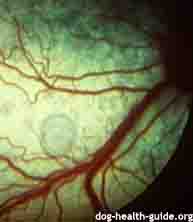Table of Contents
Overview | Foreign Object | Distemper | Canine Glaucoma | Infection | Natural Support
Summary:
"It is important to address all cases red eyes in dogs since many causes
can lead to vision problems. The dog conjunctivitis cure needed is based
on the underlying cause of the condition. Conjunctivitis is also commonly referred to as pink eye.
Overview
Look in each eye to see if you can spot any foreign matter, such as an eyelash. In young dogs the most common cause is allergy or something in the environment that is irritating the eye. Follow the manufacturers directions or those described below to flush the eye. If that doesn't work, or if your dog's eye seems better at first, but then worsens, you'll need to take him to the vet. The object may have scratched his cornea or otherwise damaged his eye.

Inflammation can be caused by injury, a mild disease, or a chronic issue.
The problem is usually seen in younger dogs.
Your vet may prescribe oral antibiotics or may prescribe an antibiotic eye ointment. Medicated eye drops may also be prescribed. Make sure you use these for as long as prescribed, even if your dog's eye looks better.
Foreign Object in Eye
For objects in the eye or an allergy, the eye needs to be flushed with eyewash. If your dog is acting healthy and does not appear to be in pain, rinse the eye using a saline eyewash from any drugstore or one made for dog eye care such as OptiClear. After gently squirting in the eye with a eye wash bulb or baster wipe around the eye with a tissue or cotton ball. You should rinse the eye 2 or 3 times per day for 1 to 2 days. If the redness goes away then the irritant has been properly flushed.
If you visit a veterinarian, your vet will irrigate the eye with water or sterile saline solution. Then the vet will probably do a flurecein stain test. In this test, an orange dye is put in your dog's eye and then the eye is examined under a special light. Any other foreign objects will show up, and also any scratches or damage to the cornea will show up. Removing the foreign object is often a dog conjunctivitis cure in itself, but sometimes it has caused an infection in the eye, and then antibiotics or anti-inflammatory medication is needed.
You can remove a foreign body from your dog's eye at home by yourself if you can see the object. Look in the eye for something like an eyelash. If you see it, try flushing the eye with water. You can also use artificial tears, the kind made for humans, which are available at any pharmacy. If you can't flush the object out, take your dog to the vet.
Distemper
As a virus, the best course of action for treating distemper in dogs is to address any symptoms. In addition to red eyes, dogs experience fever and/or respiratory and gastrointestinal issues.
Dogs with distemper are treated with intravenous fluids if they have signs of anorexia (avoidance of food) or chronic diarrhea (to avoid dehydration).
Any bacterial infections are addressed with antibiotics. Dog eye discharge is wiped away and the eyes should clear as the body fights off the virus.

Source: UC Davis School of Veterinary Medicine
Dog Glaucoma
Glaucoma is a disease where fluid in the eye increases in pressure beyond normal levels, indicating that fluid is not draining properly.
Other symptoms beyond conjunctivitis are eye spasms (blepharospasm), pupil dilation and vision loss.
The best dog conjunctivitis cure or treatment approach are medications to lower the pressure (IOP) and surgery if needed.

Source: UC Davis
Dog Eye Infection
For an infection caused by a virus, anti-inflammatory medication will be prescribed by your veterinarian. This will reduce the inflammation and swelling of the mucous membranes around the eye. It may be administered orally, but will probably be given in the form of eye drops.
For an infection caused by bacteria, antibiotics will be given. These may be given orally or by an ointment for the eye. Sometimes both are prescribed. Since it's impossible to know if the infection is viral or bacterial unless a cultural is done, and that takes time and can be costly, most vets will go ahead and prescribe antibiotics just to be on the safe side. Anti-inflammatory medication may be prescribed as well.
Be careful when wiping around the eye. Conjunctivitis is very contagious, and you don't want to spread it from one eye to the next or make the condition worse if one eye is healing faster than the other.
Natural Approaches for Additional Support
If conjunctivitis is a frequent problem or if the eye always looks red, consider natural medicine to boost the health of the eye itself. Herbs such as Burdock (for cleansing), Rosemary (cleanse and soothe), Chelidonium majus (supports the immune system) and Meadowsweet (for soothing the eyes and conjunctiva). Pet Alive Eye-Heal is worth researching as a natural treatment for bacterial conjunctivitis. Discuss this and other dog conjunctivitis cure options with your veterinarian.
Pet parents can also make your own eyewash by combining 1/4 teaspoon of salt to 1 cup of boiled (to purify the water), filtered water. Let cool before use. Herbs can be added and then filtered out of the solution. Helpful herbs include Goldenseal, Calendula and Hypericum.
Reference
Blackwell's Five Minute Veterinary Consult
